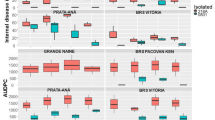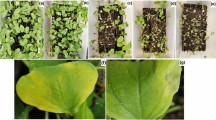Abstract
Genetic variability among Fusarium oxysporum f. sp. passiflorae (FOP) isolates changes their aggressiveness pattern under controlled conditions. This study aimed at assessing the aggressiveness of FOP isolates in Passiflora edulis seedlings through survival analysis as well as anatomic analyses of infected roots. The study followed a completely randomized design with nine FOP isolates used to inoculate 30 P. edulis seedlings. Data were subjected to survival analysis based on Kaplan-Meier curves. The number of chlamydospores in the roots was counted through root clarification and microscopy. The incidence of wilted plants ranged from 20% to 90% of the isolates with an average of 50%. Isolate CMF3115 was the most aggressive with 70% of dead plants up to 70 d.a.i. and only 3% of plants surviving the disease. Although this outcome is possibly not correlated to mortality, this isolate was also responsible for large numbers of chlamydospores in roots. Thus, CMF3115 has the potential to be used for Passiflora germplasm screening under controlled conditions and may contribute to the selection of P. edulis cultivars resistant to FOP.




Similar content being viewed by others
References
Akhter, A., Hage-Ahmed, K., Soja, G., & Steinkellner, S. (2016). Potential of fusarium wilt-inducing chlamydospores, in vitro behaviour in root exudates and physiology of tomato in biochar and compost amended soil. Plant and Soil. https://doi.org/10.1007/s11104-016-2975-1
Alfenas, A. C., Ferreira, F. A., Máfia, R. G., & Gonçalves, R. C. (2007). Isolamento de fungos fitopatogênicos. In A. C. Alfenas & R. G. Máfia (Eds.), Métodos em fitopatologia, Editora UFV, Viçosa (pp. 53–91). UFV.
Arias, M. M. D., Leandro, L. F., & Munkvold, G. P. (2013). Aggressiveness of Fusarium species and impact of root infection on growth and yield of soybeans. Phytopathology. https://doi.org/10.1094/PHYTO-08-12-0207-R
Bennett, R. S., & Davis, R. M. (2013). Method for rapid production of fusarium oxysporum f. sp. vasinfectum chlamydospores. J Cotton Sci, 17(1), 52–59.
Carvalho, A. B., Coelho, V. J. E., Araújo, K. L., de Siqueira, K. A. A., da Silva Neves, S. M. A., Soares, M. A., & Neves, L. G. (2015). Genetic variability of Fusarium solani and Fusarium oxysporum f. sp. passiflorae isolates from Pantanal, Amazon and Cerrado biomes of Mato Grosso, Brazil. Afr J Agric Res, https://doi.org/10.5897/AJAR2015.10354.
Cavalcanti, M. P., Barbosa, C. J., Schnadelbach, A. S., Haddad, F., Oliveira, S. A. S., Barbosa, L. V, Bragança, C. A. D. & Patrocinio, E. (2016) Molecular identification of Fusarium spp. associated with fusarium wilt of passionflower with emphasis in the state of Bahia. Sequence data available at <https://www.ncbi.nlm.nih.gov/popset/?term=KX185733>
Cerqueira-Silva, C. B. M., Jesus, O. N., Santos, E. S., Corrêa, R. X., & Souza, A. P. (2014). Genetic breeding and diversity of the genus Passiflora: Progress and perspectives in molecular and genetic studies. International Journal of Molecular Sciences. https://doi.org/10.3390/ijms150814122
Daranas, N., Badosa, E., Francés, J., Montesinos, E., & Bonaterra, A. (2018). Enhancing water stress tolerance improves fitness in biological control strains of lactobacillus plantarum in plant environments. PLoS One, 13, 1–21. https://doi.org/10.1371/journal.pone.0190931
Ding, Z., Xu, T., Zhu, W., Li, L., & Fu, Q. (2020). A MADS-box transcription factor FoRlm1 regulates aerial hyphal growth, oxidative stress, cell wall biosynthesis and virulence in Fusarium oxysporum f. sp. cubense. Fungal Biology. https://doi.org/10.1016/j.funbio.2020.02.001.
Ferreira, R. B., Rodrigues, A. A. C., Moraes, F. H. R., Candido, E. K., & Nascimento, I. O. (2015). Resíduos orgânicos no controle de Fusarium oxysporum f. sp. passiflorae em maracujazeiro amarelo (Passiflora edulis f. flavicarpa). Acta Biol Colomb, https://doi.org/10.15446/abc.v20n3.44720.
Flores, P. S., Otoni, W. C., Dhingra, O. D., de Souza Diniz, S. P. S., Dos Santos, T. M., & Bruckner, C. H. (2012). In vitro selection of yellow passion fruit genotypes for resistance to Fusarium vascular wilt. Plant Cell Tiss Org. https://doi.org/10.1007/s11240-011-0009-5
Freitas, J. C. O., Viana, A. P., Santos, E. A., Paiva, C. L., Silva, F. H. L., Amaral Jr., A. T., Souza, M. M., & Dias, V. M. (2016). Resistance to Fusarium solani and characterization of hybrids from the cross between P. mucronata and P. edulis. Euphytica, https://doi.org/10.1007/s10681-015-1588-8.
Galeana-Sánchez, E. (2017). Fumonisin B1 produced in planta by Fusarium verticillioides is associated with inhibition of maize β-1, 3-glucanase activity and increased aggressiveness. Physiol Mol Plant P, https://doi.org/10.1016/j.pmpp.2017.07.003.
Gordon, T. R. (2017). Fusarium oxysporum and the fusarium wilt syndrome. Annual Review of Phytopathology. https://doi.org/10.1146/annurev-phyto-080615-095919
IBGE (Instituto Brasileiro de Geografia e Estatística). (2020). Banco de dados agregados. Sistema IBGE de Recuperação Automática – SIDRA. Disponível em: http://www.ibge.gov.br.
Jesus, O. N., Santos, I. S., Lima, L. K. S., Soares, T. L., & Oliveira, E. J. (2021). Field assessment of a second generation backcross (BC1× Passiflora edulis) of passion fruit for agronomic performance and resistance to CABMV. Plant Breeding. https://doi.org/10.1111/pbr.12888
Kalbfleisch, J. D., & Prentice, R. L. (1980). Statistical analysis of failure time data. Wiley.
Kaplan, E. L., & Meier, P. (1958). Nonparametric estimation from incomplete observations. Journal of the American Statistical Association, https://www.jstor.org/stable/2281868
Kavroulakis, N., Ntougias, S., Zervakis, G. I., Ehaliotis, C., Haralampidis, K., & Papadopoulou, K.K. (2007). Role of ethylene in the protection of tomato plants against soil-borne fungal pathogens conferred by an endophytic Fusarium solani strain. J Exp Bot, https://doi.org/10.1093/jxb/erm230
Kleinbaum, D. G., & Klein, M. (2010). Survival analysis (Vol. 3). Springer.
Kumar, S., Stecher, G., Li, M., Knyaz, C., & Tamura, K. (2018). Mega X: Molecular evolutionary genetics analysis across computing platforms. Molecular Biology and Evolution, 35, 1547–1154. https://doi.org/10.1093/molbev/msy096
Leslie, J. F., & Summerell, B. A. (2008). The Fusarium laboratory manual. John Wiley & Sons.
Lima, L. K. S., Jesus, O. N., Soares, T. L., Oliveira, S. A. S., Haddad, F., & Girardi, E. A. (2019). Water deficit increases the susceptibility of yellow passion fruit seedlings to fusarium wilt in controlled conditions. Sci Hort. https://doi.org/10.1016/j.scienta.2018.09.017
Lima, L. K., Santos, I. S., Goncalves, Z. S., Soares, T. L., Jesus, O. N., & Girardi, E. A. (2018). Grafting height does not affect fusarium wilt control or horticultural performance of Passiflora gibertii NE Br. Rootstock. An Acad Bras Ciênc, https://doi.org/10.1590/0001-3765201820180072.
Liu, B., Liang, J., Tang, G., Wang, X., Liu, F., & Zhao, D. (2019). Drought stress affects on growth, water use efficiency, gas exchange and chlorophyll fluorescence of Juglans rootstocks. Sci Hort. https://doi.org/10.1016/j.scienta.2019.02.056
Lombard, L., Sandoval-Denis, M., Lamprecht, S. C., & Crous, P. W. (2019). Epitypification of Fusarium oxysporum clearing the taxonomic chaos. Persoonia. https://doi.org/10.3767/persoonia.2019.43.01
Masachis, S., Segorbe, D., Turrà, D., Leon-Ruiz, M., Fürst, U., El Ghalid, M., & Di Pietro, A. (2016). A fungal pathogen secretes plant alkalinizing peptides to increase infection. Nature Microbiology. https://doi.org/10.1038/nmicrobiol.2016.43
Melo, N. J. D. A., Negreiros, A. M. P., Medeiros, H. L. D. S., & Sales Júnior, R. (2019). Evaluation of fusarium wilt disease in passion fruit species inoculated with Fusarium oxysporum f. sp. passiflorae. J Phytopathol, https://doi.org/10.1111/jph.12871.
Mezzomo, R., Rolim, J. M., Santos, Á. F. D., Poletto, T., Walker, C., Maciel, C. G., & Muniz, M. F. B. (2019). Aggressiveness of Fusarium oxysporum and Fusarium solani isolates to yerba-mate and production of extracellular enzymes. Summa Phytopathologica. https://doi.org/10.1590/0100-5405/198057
Miedaner, T., & Schilling, A. G. (2004). Competition effects among isolates of Fusarium culmorum differing in aggressiveness and mycotoxin production on heads of winter rye. European Journal of Plant Pathology. https://doi.org/10.1023/B:EJPP.0000010136.38523.a9
Nirmaladevi, D., Venkataramana, M., Srivastava, R. K., Uppalapati, S. R., Gupta, V. K., Yli-Mattila, T., & Chandra, N. S. (2016). Molecular phylogeny, pathogenicity and toxigenicity of Fusarium oxysporum f. sp. lycopersici. Sci Rep, https://doi.org/10.1038/srep21367.
Ortiz, E., Cruz, M., Melgarejo, L. M., Marquínez, X., & Hoyos-Carvajal, L. (2014). Histopathological features of infections caused by Fusarium oxysporum and F. solani in purple passionfruit plants (Passiflora edulis Sims). Summa Phytopathol, https://doi.org/10.1590/0100-5405/1910.
Pandey, P., Irulappan, V., Bagavathiannan, M. V., & Senthil-Kumar, M. (2017). Impact of combined abiotic and biotic stresses on plant growth and avenues for crop improvement by exploiting physio-morphological traits. Frontiers in Plant Science, 8, 1–15. https://doi.org/10.3389/fpls.2017.00537
Pereira, P. P. A., Lima, L. K. S., Soares, T. L., Laranjeira, F. F., de Jesus, O. N., & Girardi, E. A. (2019). Initial vegetative growth and survival analysis for the assessment of fusarium wilt resistance in Passiflora spp. Crop Protection. https://doi.org/10.1016/j.cropro.2019.03.018
Peto, R., & Peto, J. (1972). Asymptotically efficient rank invariant test procedures. J R Stat Soc A Stat: https://www.jstor.org/stable/2344317
Phillips, J. M., & Hayman, D. S. (1970). Improved procedures for clearing roots and staining parasitic and vesicular-arbuscular mycorrhizal fungi for rapid assessment of infection. Transactions of the British Mycological Society. https://doi.org/10.1016/S0007-1536(70)80110-3
Preisigke, S. D. C., Silva, L. P. D., Serafim, M. E., Bruckner, C. H., Araújo, K. L., & Neves, L. G. (2017). Seleção precoce de espécies de Passiflora resistente a fusariose. Summa Phytopathologica. https://doi.org/10.1590/0100-5405/175390
R Development Core Team, 2020. R: A language and environment for statistical computing. R Foundation for statistical computing. Vienna. Available in: https://cran.r-project.org/. Accessed 20 Feb 2020.
Rasband, (2016), ImageJ, U. S. National Institutes of Health, Bethesda, Maryland, USA http://imagej.nih.gov/ij/ accessed 10 August 2019.
Silva, A. D. S., Oliveira, E. J. D., Haddad, F., Jesus, O. N., Oliveira, S. A. S. D., & Costa, M. A. P. D.C. (2013b). Molecular fingerprinting of Fusarium oxysporum f. sp. passiflorae isolates using AFLP markers. Sci Agr, https://doi.org/10.1590/S0103-90162013000200008.
Silva, A. D. S., Oliveira, E. J. D., Haddad, F., Laranjeira, F. F., Jesus, O. N., Oliveira, S. A. S. D., & Freitas, J. P. X. D. (2013a). Identification of passion fruit genotypes resistant to Fusarium oxysporum f. sp. passiflorae. Trop Plant Pathol, https://doi.org/10.1590/S1982-56762013005000008.
Singh, N., Mukherjee, S. K., & Rajam, M. V. (2020). Silencing of the ornithine decarboxylase gene of Fusarium oxysporum f. sp. lycopersici by host-induced RNAi confers resistance to fusarium wilt in tomato. Plant Mol Biol Rep, 1-11. https://doi.org/10.1007/s11105-020-01205-2.
Souza, P. U., Lima, L. K. S., Soares, T. L., de Jesus, O. N., Coelho Filho, M. A., & Girardi, E. A. (2018). Biometric, physiological and anatomical responses of Passiflora spp. to controlled water deficit. Sci Hort, https://doi.org/10.1016/j.scienta.2017.10.019.
Tibisco Software Inc. (2018). Statistica (data analysis software system), version 13.
Acknowledgments
The Coordenação de Aperfeiçoamento de Pessoal de Nível Superior (CAPES) provided a masters research grant to the first author (R.A.P.). The Conselho Nacional de Desenvolvimento Científico e Tecnológico (CNPq) provided a postdoctoral scholarship to the third author (L.K.S.L - PDJ 152109/2019-6), financial support (Process 421033/2018-5) and a research productivity fellowship to the second and last author (O.N.J - PQ312774/2018-4; F.F.L PQ309895/2016-2). The Embrapa Mandioca e Fruticultura research unit provided the plant material along with experimental, technical and financial support (Process 22.16.04.007.00.00).
Availability of data and material
Not applicable.
Code availability
Not applicable.
Funding
This work was funded by the Conselho Nacional de Desenvolvimento Científico e Tecnológico (CNPq, Process#: 421033/2018–5) and macroprogram of Embrapa Mandioca e Fruticultura (Process#:22.16.04.007.00.00).
Author information
Authors and Affiliations
Contributions
All authors contributed to writing, as well as toward interpreting the results, revising, and improving the paper. RAP and LNS performed the installation and conduct of the experiment and drafted the manuscript. LKSL, ONJ e FFL participated in the statistical analysis, and data interpretation. ONJ e FFL made corrections in the writing of the manuscript. LKSL, ONJ e FFL were the creators of the research.
Corresponding author
Ethics declarations
Conflict of interest
The authors declare that they have no conflicts of interest.
Ethics approval
Not applicable.
Consent to participate
Not applicable.
Consent for publication
Not applicable.
Rights and permissions
About this article
Cite this article
Pires, R.A., Jesus, O.N., Lima, L.K.S. et al. Fusarium oxysporum f. sp. passiflorae isolates display variable virulence in Passiflora edulis Sims seedlings. Eur J Plant Pathol 162, 465–476 (2022). https://doi.org/10.1007/s10658-021-02417-2
Accepted:
Published:
Issue Date:
DOI: https://doi.org/10.1007/s10658-021-02417-2




